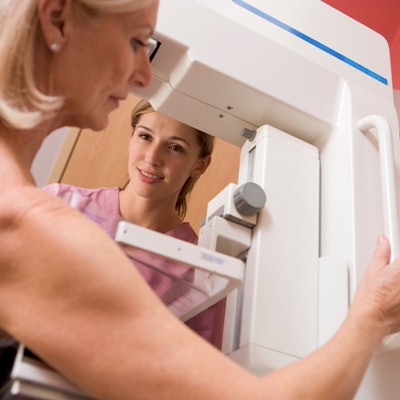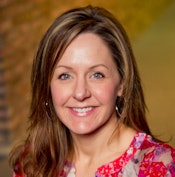
The idea of one-size-fits-all breast cancer screening is being questioned, and breast imaging centers are pressed to offer tailored services beyond imaging that take an individual woman's risk factors into account. So how can a center provide top-notch risk assessment -- that's also feasible? There are six things to consider, according to a talk at the RSNA 2016 meeting.
As part of a special interest session on how radiologists can improve mammography screening in the U.S., presenter Mary Freivogel of Invision Sally Jobe in Denver described her center's process of establishing a systematic risk assessment program, which Sally Jobe began in 2009. Freivogel is a genetic counselor at Sally Jobe and the 2017 president of the National Society of Genetic Counselors (NSGC).
 Mary Freivogel of Invision Sally Jobe.
Mary Freivogel of Invision Sally Jobe.Breast centers are ideal places to offer this kind of service, she said.
"Establishing a risk assessment program is so important, especially since there's so much confusion right now about breast cancer screening guidelines," she told session attendees. "Every professional organization agrees that women at higher risk need to be managed differently, so we need to identify those women and personalize their screening protocol."
6 tips
Freivogel offered six recommendations for breast centers interested in establishing -- or refining -- their risk assessment program.
1. Do something
"There are more practices than you might think that are doing nothing to establish a risk assessment program," she said. "But breast centers are ideal for risk assessment, and patients at higher risk are more common than you'd guess."
Freivogel estimated that 13% of Sally Jobe patients who present for a mammogram are at high risk, with 9% being candidates for genetic counseling, 2.5% being candidates for breast MR in addition to mammography, and 1.5% being candidates for both.
2. Use the right model for your purpose
"You want to ask yourself, 'Why am I doing this risk assessment?' " Freivogel said. "Not all models are equal. For example, if you're trying to identify women who need breast MRI as a supplement to mammography, the Gail model is not a good choice; it takes limited family history information and doesn't distinguish details like at what age the woman's nearest relative was diagnosed with breast cancer. Choose the model you need based on what you're trying to do."
3. Ask the right questions
It's important to be comprehensive in the intake process, asking not only whether breast cancer is in the patient's maternal or paternal family lines -- including second-degree relatives and cousins -- but also if the patient's family history includes other relevant cancers, such as ovarian, pancreatic, or prostate, Freivogel said.
"Find out if she's had genetic testing, or if any of her relatives have, and what the results showed. Ask if she's had previous breast biopsies and, if so, what was the pathology?" she said."We also need to know if a patient has Ashkenazi Jewish ancestry, because those women have a one in 30 to a one in 50 chance of carrying the BRCA gene mutation, compared with a one in 500 chance for women who are not Jewish."
4. Don't assume that risk assessment is a one-time deal
It's dangerous to treat breast cancer risk assessment as a "one-and-done" process, according to Freivogel. In fact, a woman's risk changes over time, and she should be assessed each year.
"You might have a patient who comes in one year without any family history of breast cancer, but the next year she does," she said. "Age changes risk as well: As we live out another year of our lives, we live out another year of risk."
Even patients who have been candidates for breast MRI may not be candidates the following year, and patients who have had genetic counseling may need it again, Freivogel said.
5. Get a genetic counselor involved
"If you don't have a working relationship with a genetic counselor, please establish one," Freivogel said. "Or hire one or two. They not only see patients, but they can help you set up your risk assessment program, partner with patient navigators, and help patients better understand what genetic testing is and therefore make informed decisions about it."
At Sally Jobe, 30% of patients who come in for genetic counseling are new to the practice, and half of these become ongoing patients, she said. In addition, patients who have seen a genetic counselor are often higher risk and tend to be associated with higher revenue for the practice. They also often refer friends and family, and those who have an intervention with a genetic counselor are more likely to be compliant with high-risk recommendations, such as breast MRI, according to Freivogel. She suggested consulting NSGC's Find a Genetic Counselor resource on its website.
6. Involve the patient
When Invision Sally Jobe established its screening program, it began by sending recommendations regarding breast MRI and genetic counseling to the patients' referring physicians. A year into the program, the center began sending letters to patients as well, inviting them to schedule an appointment with their referring physician to discuss their risk.
"The letters were carefully worded, using gentle language," Freivogel said. "That's when our breast MRI volume began to climb: When we went directly to the patient and made sure that they were in the communication loop as well."
Healthcare providers can't predict if or when breast cancer will occur, but in addition to regular screening, providing risk assessment support is a key service, Freivogel concluded.
"We can help patients understand if they are at increased risk and empower them to follow a personalized screening plan in conjunction with their referring physician," she said. "Hopefully these efforts will lead to early detection -- if not prevention -- of breast cancer."




















